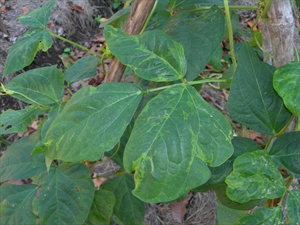Bean common mosaic virus, common mosaic of beans.
Pacific Pests, Pathogens and Weeds - Online edition
Pacific Pests, Pathogens & Weeds
Bean common mosaic (043)
Bean common mosaic virus. The abbreviation is BCMV.
Asia, Africa, North, South and Central America, the Caribbean, Europe, Oceania. It has been recorded from Australia, Fiji, New Zealand, and Solomon Islands.
The virus has been recorded in the following legumes in Fiji and Solomon Islands: Calopogonium mucunoides, Centrosema pubescens, Clitorea ternatea, Desmodium heterophylum, Macroptilium atropurpureum, Macroptilium lathyroides, Phaseolus vulgaris (French beans), Phaseolus coccineus, Pisum sativum, Pueraria phaseoloides, Stylosanthes guianensis, Vigna marina, Vigna unguiculata ssp. sesquipedalis (long bean or yard long bean). Cowpea and soybean are also hosts. In a 2007 survey in Solomon Islands the virus was recorded in wild passion fruit, Passiflora foetida.
Patches of light and dark green on the leaves (mosaics), with distortions. If the first leaves are discoloured, and misshapen, and the plants are stunted (Photo 1), then it is likely that the seed was infected by Bean common mosaic virus.
Aphids (green fly) spread the virus in a 'non-persistent way'; this means that after feeding on a plant infected with virus it can straight away move to a healthy plant and transmit (spread) the virus as it feeds again. The virus is also spread in seed. Seed infection can be high, over 30%. It can then be spread from these plants by aphids, and it is not uncommon to see all long beans or French beans in a plot with symptoms of the virus.
The virus can remain alive in bean seeds for many years. The virus is also spread in pollen. However, seed and aphid transmission are the most important methods of spread.
The virus is important on long bean, especially when infection comes from planting diseased seed. In this case, symptoms appear early: plants are dwarfed, pods are shorter and fewer than normal and, consequently, yields are low.
Look for patches of light and dark green on the leaves (this symptom is called a mosaic - Photos 1-4), and for leaves that are misshapen. The leaves may be puckered, with bumps on the surface of the leaves (Photo 1).
CULTURAL CONTROL
Cultural control is important. The following applies to food legumes, yard long and French beans, in particular:
Before planting:
- The virus is seed borne, therefore:
- Carefully select plants for seed that do not show symptoms of the disease.
- If most plants show symptoms, do not use them as a source of seed; obtain seeds from reliable sources, a commercial company or from local growers whose plants have been monitored for the disease.
- Plant mixtures of long bean varieties - a strategy used in parts of Africa. However, little is known about the proportion of resistant varieties in the mixture to give the desired effect.
- Do not plant new crops next to those that have the disease.
During growth:
- Interplant beans with other plants, e.g., maize.
After harvest:
- Collect and remove all debris and burn it.
RESISTANT VARIETIES
Although there are known differences between Phaseolus vulgaris varieties in other parts of the world, as yet, there have been no reports from Pacific island countries. Currently, trials with long bean (Vigna unguiculata ssp. sesquipedalis) are being done in Pacific island countries with varieties of long beans from AVRDC (now known as The World Vegetable Center).
CHEMICAL CONTROL
The use of insecticides for the control of aphids that spread the virus is not recommended. The time is short between an aphid sucking up the virus when it feeds on a diseased plant and spreading the virus as it feeds again on a healthy plant. By the time the insecticide has killed the aphid it has spread the virus.
Should growers wish to use an insecticide to kill aphids, use those given under Aphids (see Fact Sheet no. 38):
- Plant-derived products, such as neem, derris, pyrethrum and chilli (with the addition of soap).
- Note, a variety of Derris, brought many years ago to Solomon Islands from Papua New Guinea, is effective as a spray. It contains rotenone, an insecticide, so it should be used with caution. There may be varieties of Derris (fish poisons) in your country that can be tried (see Fact Sheet no. 56).
- Synthetic pyrethroids are likely to be effective, but will also kill natural enemies of aphids.
____________________
When using a pesticide, always wear protective clothing and follow the instructions on the product label, such as dosage, timing of application, and pre-harvest interval. Recommendations will vary with the crop and system of cultivation. Expert advice on the most appropriate pesticides to use should always be sought from local agricultural authorities.
AUTHORS Helen Tsatsia & Grahame Jackson
Information from Schwartz HF, et al. (2016) Bean common mosaic virus (BCMV). BugwoodWiki. (https://wiki.bugwood.org/HPIPM:Bean_Common_Mosaic_Virus#:~:text=Bean%20common%20mosaic%20virus%20(BCMV)%20causes%20Bean%20common%20mosaic%20of,the%20field%20or%20nearby%20field.&text=The%20virus%20can%20infect%20few%20plants%20beside%20dry%20bean); and CABI (2019) Bean common mosaic virus (common mosaic of beans). Crop Protection Compendium. (https://www.cabi.org/cpc/datasheet/9424); and from GrowVeg (undated) Bean mosaic virus Bean Common Mosaic Virus (BCMB). (https://www.growveg.com.au/plant-diseases/uk-and-europe/bean-mosaic-virus/).
Produced with support from the Australian Centre for International Agricultural Research under project PC/2010/090: Strengthening integrated crop management research in the Pacific Islands in support of sustainable intensification of high-value crop production, implemented by the University of Queensland and the Secretariat of the Pacific Community.







